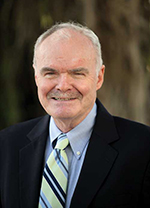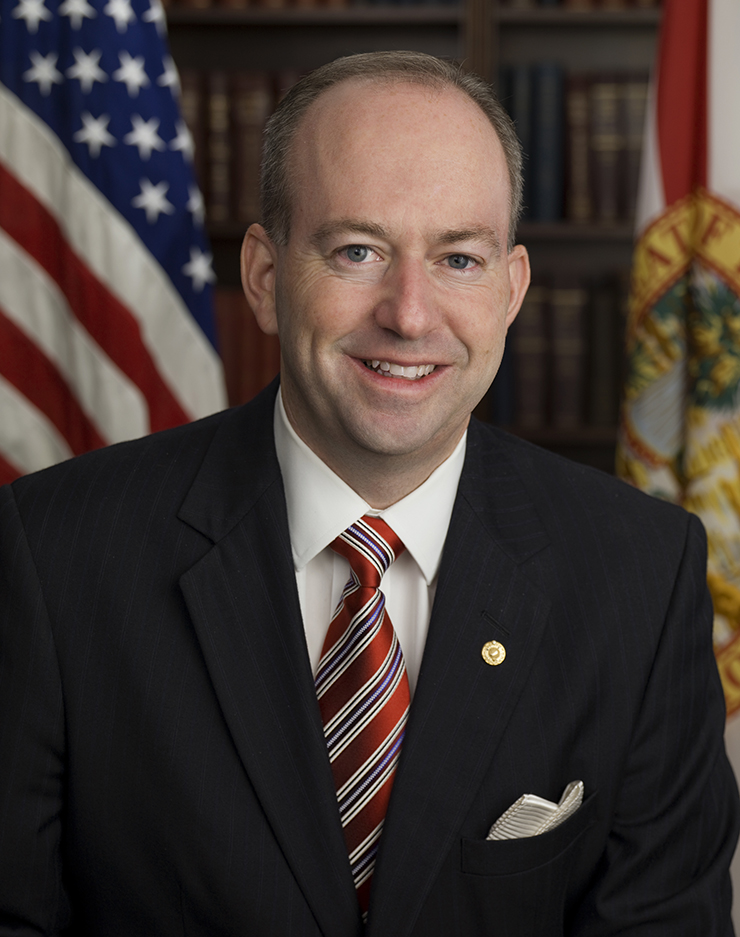
George LeMieux has an impressive resume. The chairman of one of the state’s largest law firms, Gunster Law Firm, graduated with honors from Emory University and was president of his fraternity. He was cum laude from Georgetown Law and interned for former U.S. Congressman E. Clay Shaw, Jr. and U.S. Senator Connie Mack III. He was chairman of the Broward County Republican Party. He became deputy attorney general for Florida, chief of staff in the attorney general’s office under Gov. Charlie Crist, and served two years in the United States Senate. The LeMieux Center for Public Policy at Palm Beach Atlantic University is named for him.
Add to that formidable list another credit: author. Hot off the presses of The History Press in South Carolina is Florida Made—The 25 Most Important Figures Who Shaped The State. LeMieux wrote the book with co-author Laura E. Mize, a former reporter for the Palm Beach Post. They worked on it for several years and ranked their top 25 according to importance. If you guessed Henry Flagler is first on the list, you are right. But that’s about the only one you are likely to hit on the nose.
That is acknowledged in the introduction: “Some of our choices will surprise you. Quite a few may be unknown to you. A couple will be unpopular.” The selection and rankings are based on this question: “If that person had not contributed to Florida in the way he or she did, what would have happened? It is not enough that a person was the first to do something significant. The real question is: Absent his or her influence, how would Florida be different?”
Thus we find high on the list, in third place, is a fellow many would recognize by the shortened form of his full name, Fidel Alejandro Castro Ruz. (See what they mean by unpopular?) And you have to go all the way to the bottom of the list to find anyone who is still with us. H. Wayne Huizenga, who Gold Coast magazine described a few years ago as second only to Henry Flagler in his contributions to the state, made the cut, but just barely.
Obviously, the book is something of a surprise party, and we won’t spoil that celebration by revealing all the names. Let’s just say authors LeMieux and Mize make good cases for their selections and support their scholarship with 62 pages of notes and a bibliography. It’s an easy read—even fun—and often entertaining in its rationale for some of the choices. It's a creative education even for those who think they know 500 years of Florida history.
Image via

Always a hands-on manager, Penske helped push his racer off the track during time trials.
It was 7:30 a.m. Monday following the 1969 Memorial Day Indianapolis 500. The owner was at his desk signing letters. He had 130 of them, all thank yous to people who had been helpful to him for the last month.
“It doesn’t take much time and people appreciate it,” he explained. The owner had his own Chevrolet dealership in West Philadelphia, which he had purchased after working three years as its general manager. The dealership was his job. As a sideline he also owned a racing car team, which had just participated for the first time in the greatest spectacle in racing.
For a rookie team, it had gotten an extraordinary amount of publicity. It had a big-time sponsor, Sun Oil Company, headquartered in Philadelphia not far from the auto dealership. The race car, an innovative four-wheel drive Lola, had been the talk of the race. His driver, although new to the oval track, was already becoming a legend as one of the most successful sports car racers of the day. He was a novelty in the sport—an engineer with a degree from Brown University who contributed to the design and technical aspects of his own racers. The team had lived up to its press, turning in some of the fastest times in qualifying.
However, the team did not win (Mario Andretti did), and the owner was disappointed, but hardly discouraged. His car had been running third late in the race before engine problems forced it out, and into a seventh-place finish. The thing that went wrong was almost a freak—a magneto had failed, shutting down the engine. However, the months of preparation, including most of the month of May spent in rookie qualification and time trials, had been a valuable learning experience. The owner seemed confident his team could win at Indy. He thought it would take three years.
He was wrong, but not by much. Roger Penske took four years to win his first Indy. Mark Donohue drank the victory milk in 1972. Three years later he was dead—cerebral hemorrhage a few days after crashing in practice for the Austrian Grand Prix. Penske, who stopped driving himself after a spectacular crash in a sports car race, lives on. Last weekend he won the Indianapolis 500 for the 17th time. LeBron James’ extraordinary basketball feat on the same weekend pales beside it. Talk about records that will never be broken. The two second-most winning Indianapolis owners—one of whom is Michael Andretti—have five. And, at age 80, Roger Penske is not finished.
What makes Penske so successful was apparent that morning almost 50 years ago when he was signing thank you letters at 7:30 in the morning. They had obviously been prepared in advance. The race had been on a Friday, and the next two days following the big event are always hectic. There are award dinners and teams breaking down their garages to go home. It can be very tiring, but here was Penske on the next working day at his office at the crack of dawn. Any fool could see him coming.
What took this fool to Indy for Penske’s 500 debut was largely a business decision. Philadelphia magazine was trying to develop automobile advertising. It began doing stories to support that effort. It did a piece on luxury cars and the guy who sold Rolls-Royces. We rented a limo for a day and wrote about the thrill of driving around town thumbing our noses at the poor slobs driving 10-year-old rust buckets. One of the writers even rode with a motorcycle gang for a few weeks. And then we decided to do something on auto racing. Stock cars were not the magazine’s audience, but a young fellow who had begun getting some notice as a sports car racer when still a student at Lehigh University was more our speed.
I had never seen an auto race of any kind, but my first car had been a 1958 Porsche (used but in immaculate condition), and my second a small BMW sedan, one of the first in the country. Only motorcycle buffs recognized the blue and white propeller emblem, a recognition of the company’s start as an aircraft engine builder. So I was aware of the racing history of those brands. When we read that Penske was jumping from road racing to the big time of Indy, and his sponsor was Sunoco, whose office was around the corner from the magazine, it seemed like a natural.
I contacted Penske more than a month before the race. He could not have been more cooperative, taking me to the suburban Philadelphia facility where his car was being prepared, letting me ride on a private plane with him back and forth from Indy in the weeks before the race, and arranging for me to be on the grid as the drivers got that famous “Gentlemen, start your engines!” command. He must have sensed how little I knew about racing, but was too tactful to say it.
His touch with the press is one of the qualities that has served the man now known as “the captain” so well over his career. From the start he was meticulous about detail, a demanding boss who drove his mechanics crazy by insisting they break down engines that were running fine. Penske became famous for the phrase “the unfair advantage,” meaning a better race car and driver. But he was always gracious in a game that back in that era had its share of rough characters. Those 130 thank you letters tell the story.
That year at Indy there was always a mob scene around his garage. Penske, whose nature is order, would get upset about all the people hovering over his mechanics, and order everybody out of the garage. Then, spotting a writer standing outside in the masses, he would motion you to come back in. He did this with others until within minutes the garage was crowded again.
His close relationship with Mark Donohue was palpable. Donohue was reserved and quietly polite, with a soft face that masked his fiercely competitive nature. The combination of personalities inspired the title of Philadelphia magazine’s piece: “Captain Nice and Mr. Clean at Indy.” I am not aware that he ever said much about it, but Donohue’s death at the height of his fame must have been the hardest blow that Penske had to take over the years in a dangerous sport.
Penske’s talents and discipline have taken him far beyond racing. He has been a remarkably successful businessman. You see Penske rental trucks every day, and he owns auto dealerships and has number of corporate boards. He mentioned that goal on one of the flights from Indy to Philadelphia in 1969. People were predicting he would get into politics, and I asked him about it, and what he wanted to do with the rest of his life. He was 32 at the time. He seemed to ponder the question, as if not sure of his answer, then replied, “I’d like to be known as a good businessman.”
He never mentioned 17 wins at Indy.
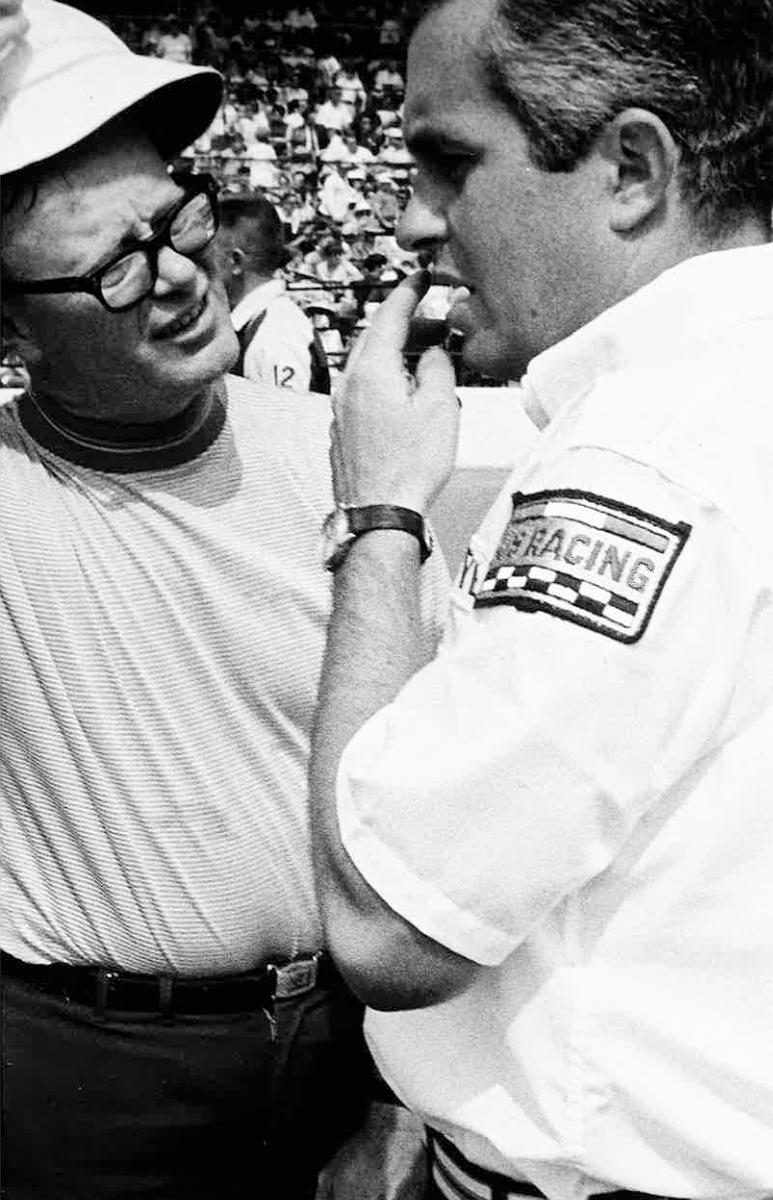
Roger Penske’s rapport with the media was always excellent. In 1969 he was interviewed at his first Indy 500 by Philadelphia sports writer Sandy Grady.
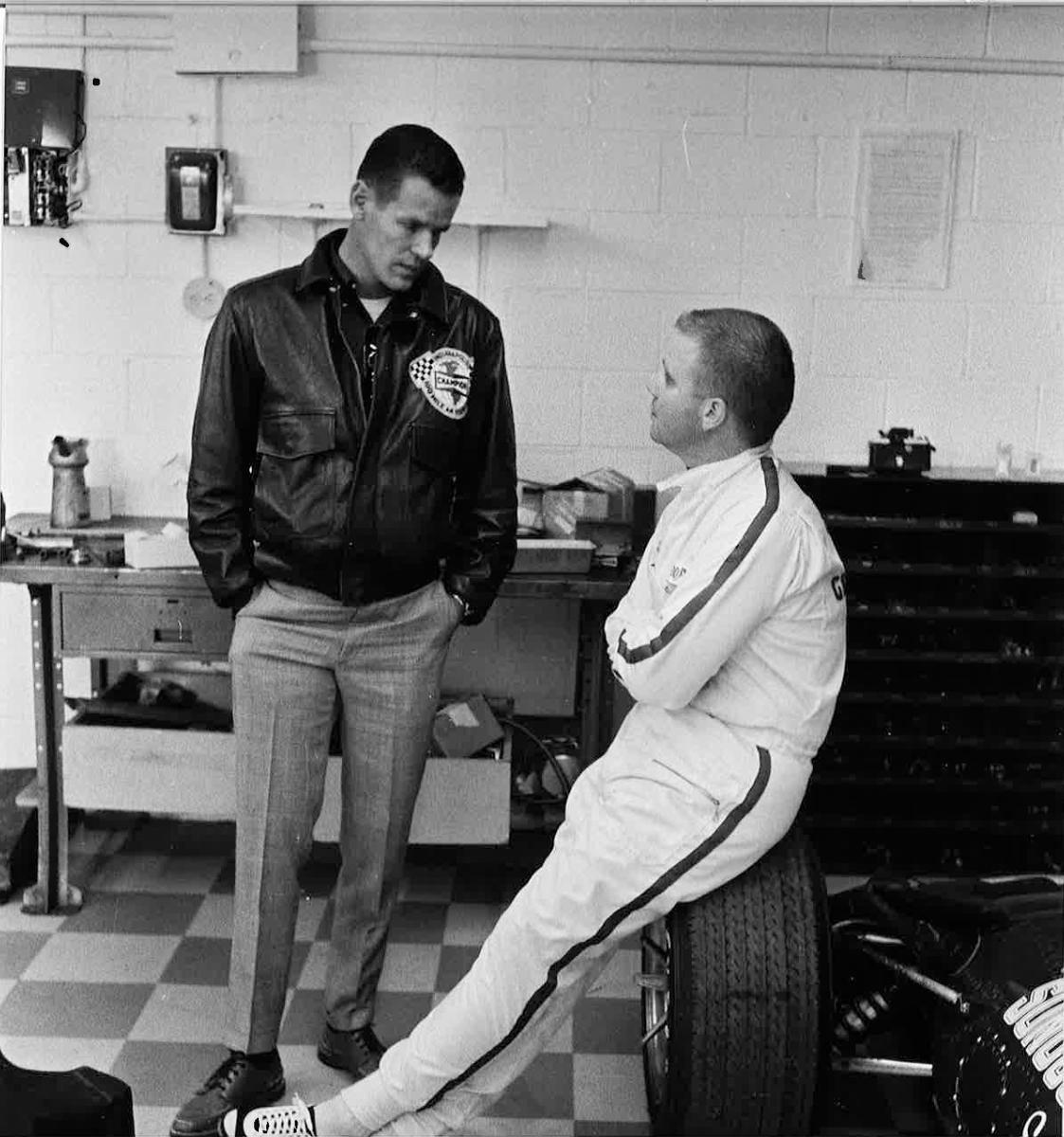
Even as a rookie owner, Penske’s garage attracted racing stars. Bobby Unser, (left) of a legendary racing family, visits with Mark Donohue.

The extension of the new Brightline train to Miami on the historic FEC Railway corridor is a giant step in making the new service realize its potential. Brightline gave its spectacular new Miami station a splashy opening two weeks ago when it ran a VIP trip along the 60-plus-mile route. We were just as impressed with this trip as we were with our ride to West Palm Beach a few weeks earlier. To go from downtown Fort Lauderdale to the heart of Miami in a little more than 30 minutes was hard to believe—even for some veteran railroad experts who flew in from around the country for the occasion.
To put that speed in perspective, a few days before we drove from Fort Lauderdale to Worth Avenue in Palm Beach. We left at 7:30 a.m., hoping to get ahead of Interstate 95 rush hour traffic. Fat chance. We arrived at 9:05 a.m., five minutes late for our meeting. It took almost 20 minutes just to get to I-95.
The guests on the trip to Miami included a number of political types who were in a separate car from us media folks. But we did get a chance to introduce ourselves to Broward County State Attorney Michael Satz before boarding the train. Unfortunately, it wasn’t Satz, and the man we harassed graciously said the misidentification has happened before.
It was just as well that they kept the Pharisees separate from the scribes, for we had a chance to talk to several visiting passenger rail experts, all of whom were effusive in their praise for Brightline. They agreed the station itself is an architectural knockout, built on what used to be the FEC’s freight yard. Although thoroughly modern, it includes a salute to the old classic stations with a soaring glass ceiling atrium (above). It is the heart of a complex still under construction—six blocks of high-rise offices, residences and retail facilities. Those familiar with Philadelphia, where Penn Center has more than a dozen tall buildings over an underground station that was once on elevated tracks, can appreciate the concept. Another example is New York City, where Madison Square Garden was built on the site of the old Penn Station above subterranean tracks. Those railroads created their own destinations. The same will happen in Miami when thousands of workers, residents and shoppers will be drawn to the MiamiCentral Station, many of them arriving by rail.
What impressed the pros we met just as much, however, was the planning that brought the three significant rail lines in South Florida together at one hub. The platform for Brightline is adjacent to one that will be used by Tri-Rail when that 20-year old commuter train is routed from its existing tracks on the westerly CSX, and (longer range) if some Tri-Trains are shifted to the FEC farther north in Broward County. Both those events will bring thousands of commuters to downtown Miami.
Adding to the convenience is the fact that the elevated Metrorail tracks are so close to the new station that a walkway is planned to connect them. That will enable commuters to quickly reach parts of the downtown too far to walk to from MiamiCentral, and even take them another 20 miles as far south as Kendall.
***
It is an irony, and not an attractive one, that at the same time this futuristic development in South Florida is taking form, another event in the making appears to offset such progress by repeating the errors of the past. We are seeing the reckless kind of building that makes transportation advances such as Brightline so badly needed.
We speak of the massive American Dream Mall, which was just approved by the Miami-Dade Commission. This is billed to become the country’s largest mall, entertainment and retail complex, which will be surrounded by a large, new housing development. Only one of 13 Miami-Dade commissioners voted against it, despite the fact that it has raised concerns about destroying even more wetlands on the edge of the endangered Everglades, and worries Broward County leaders that it will drastically increase traffic in the southwest part of the county. In fact, with a projected 70,000 vehicle trips per day, it will generate traffic everywhere in South Florida because the tens of thousands of visitors that are expected at the new complex will have to use major roads to get there. It is far from Brightline or any other mass transit system. It is just beyond the Broward County line and will likely affect us more than Dade. The American Dream could become a Broward nightmare.
As usual, the developer says it won’t affect traffic that much, and new roads will solve the problem. That is absurd and everybody knows it. They said all the new high-rises in downtown Fort Lauderdale would not impact traffic, and now we see how untrue that claim was.
Piling irony upon irony, as the papers were reporting the American Dream Mall story, they were carrying a major feature, “The Invading Sea,” on the threat of rising sea levels. Three papers—the Miami Herald, Sun-Sentinel and Palm Beach Post—all carried the series. It was capped off with Sunday editorials headlined “Wake up, S. Florida! Speak up on sea-level rise.” The papers almost screamed at readers to shake elected officials out of their ignorance, lethargy—or both—about the urgency of the situation. They even listed contact information for five of the most influential leaders.
So, at a time when efforts should be made to conserve water absorbing open land and foliage, we continue to add to the problem by paving over every available piece of land, permitting huge developments and converting open spaces such as golf courses to houses. Wake up Florida indeed. Before your bed floats away.
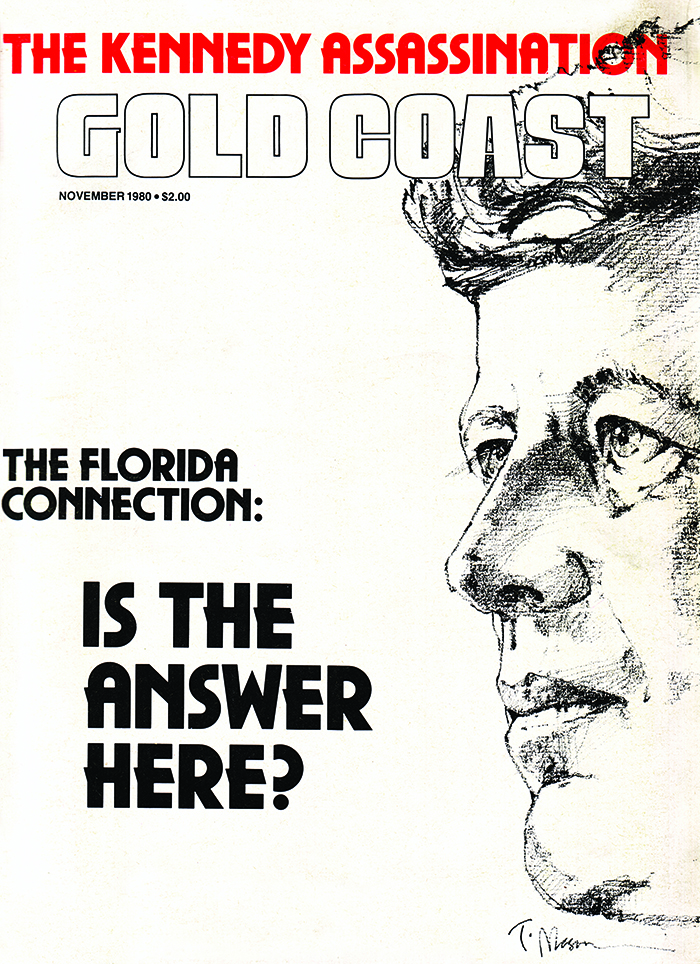
Those of us survivors who have followed the history of the Kennedy assassination and its controversial aftermath are finally getting some answers to questions that popped up soon after that tragic day 55 years ago. Or, more accurately, we are getting clues to answers, if not direct answers themselves.
One of the troubling aspects of the assassination has been the lack of action by major news outlets in questioning the official government version that Lee Harvey Oswald acted alone. Sure, there have been a plethora of books and articles written challenging that conclusion, but very little of that activity began with major news outlets. Television and newspapers merely reported what private investigators had uncovered.
That strange silence began even before the Warren Commission issued its 1964 report. No less an institution than The New York Times praised the work of the Warren Commission, but it took some time before skeptical researchers discovered that the Times’ assessment came before anyone on its staff has actually seen the full report—the 26 volumes of evidence that were full of inconsistencies and testimony from numerous witnesses that the commission chose to ignore.
Over the years major news organizations have seemed reluctant to accept conspiracy theories, even as they reported on them in detail. And in some cases, major newspapers have simply ignored dramatic information that appeared right under their noses.
We saw this up close and personal when our former employer, Philadelphia Magazine, printed one of the first articles casting doubt on the Warren Commission’s work. In 1966 Gaeton Fonzi interviewed Arlen Specter, the man who came up with the notorious “single bullet theory”—an idea necessary to support the single gunman conclusion. It was a long, detailed article, which created quite a stir locally when Specter could not explain his own theory. It actually led 10 years later to Fonzi being hired by Pennsylvania Sen. Richard Schweiker to take part in the reopened investigation of the crime.
However, at the time, the Philadelphia papers ignored Fonzi’s work. Specter continued to get favorable publicity as the man who had proved how a lone gunman killed a president. His growing reputation led to election as a U.S. Senator, an office he held for 30 years. There have been other examples over the years of important media ignoring stories in their own markets. One of the most glaring again involved Gaeton Fonzi. By then he had joined us in Florida as editor of Miami Magazine, which was sold in 1975. That’s when Sen. Schweiker contacted him to work for the government.
In late 1979, with five years of work behind him, Fonzi published a two-part article in Gold Coast magazine and The Washingtonian. The latter was an important magazine in the nation’s capital, and Fonzi had unusual credibility. He was now an insider who had dealt directly with the CIA and saw the agency’s efforts to sabotage any legitimate inquiry. In his articles, which later became “The Last Investigation,” regarded as one of the best books on the subject, Fonzi vented over the failure of two congressional committees to answer the question of who killed JFK. He had discovered a strong CIA connection to Oswald in the form of a high-ranking CIA officer who was heavily involved in anti-Castro activities in South Florida, but the House Select Committee on Assassinations, pressed for time and money, never fully followed up on that dramatic revelation.
Gold Coast could not have played the story any bigger (see cover above), but the local South Florida papers never mentioned it. The same thing happened in Washington, where Washingtonian was long established and highly influential. It sensationalized the story with a provocative cover, which resulted in the CIA officer suing for libel. He lost, but the magazine spent a lot of money defending itself. Despite all this, the former Washingtonian editor, Jack Limpert, said The Washington Post never carried a line about the story. Keep in mind the timing. This was almost 10 years after the Post showed great courage in breaking the Watergate story. More than strange.
Which brings us to the point. In recent years it has become known that major newspapers had CIA connections at the time of the Kennedy assassination. It only made sense. Reporters were stationed around the world. It was their job to have contacts that the intelligence community would find helpful, especially in places such as South Florida with all its Cuban anti-Castro activity. It did not mean that reporters were paid agents of the CIA, but it did mean they might sense a patriotic obligation to help gather intelligence when asked. And, quid pro quo, the CIA could be a valuable source of information to them. They had to be on good terms to keep up with the competition.
The fact that some reporters even had CIA code names was revealed years ago. It has long been known that the Miami News, which expired in the late 1980s, had one such reporter. Hal Hendrix impressed colleagues with his inside information on intelligence activities in Cuba and Latin America. He even won the Pulitzer Prize. But he blew his cover in 1963 when he revealed a CIA-sponsored coup in the Dominican Republic—the day before it actually happened.
And just last week the Miami Herald broke the news that among recently declassified Kennedy Assassination documents were several references to two of its own former reporters having CIA connections. Kevin Hall, a much-honored editor who works for McClatchy Newspapers out of Washington, D.C., revealed in a full page piece that the two Herald reporters, Don Bohning and Al Burt, now both dead, had CIA clearances and were assigned code names. Both covered Latin America at one time, and Burt later wrote prominent columns in the paper. Does this mean their contact with the agency was anything but normal for men in their position? Hall does not know. But it does support researchers who as early as 2005 claimed the CIA had friends at the Miami papers who could be counted on to keep some stories quiet, while promulgating others.
The more cynical among us—those close to important stories such as Fonzi’s, which were ignored by local papers—suspect that the CIA influence went beyond the newsroom grunts, and may have involved high levels of management. The initial reaction of The New York Times to the Warren Commission Report is one example. Perhaps a better one was the legendary The Washington Post editor Ben Bradlee, a friend of President Kennedy. You would expect him to be a leader of the charge when the doubts about the Warren Commission were first publicized. But he was also the brother-in-law of a high-ranking CIA officer and was close to the agency’s top leadership. He would have been reluctant to associate his social friends with such a terrible crime. In an interview with David Talbot for his 2007 book Brothers, Bradlee admitted that when the first questions about the assassination arose in the mid-1960s, he was new to his job and concerned about his career. But that insecurity does not explain why his newspaper was silent when Fonzi’s magazine article roiled Washington 15 years later, after his paper’s brilliant Watergate work, and he had become a hero played by look-alike Jason Robards in the film “All The President’s Men.”
Bradlee is gone now, so we will never know his true thoughts. All we are left with are clues. And the clues keep coming. Perhaps someday they will lead to answers.
Image: Gold Coast magazine's November 1980 cover.


One by one, friends have been testing the new Brightline service on the Florida East Coast Railway between Fort Lauderdale and Palm Beach. Uniformly, they have given the fast train rave reviews. Last week, courtesy of Brightline, our editorial staff got to ride the train. Our verdict: Those rave reviews are right on.
The latest, and easily the most influential, comes from Trains Magazine, longtime (since 1940) bible of rail transportation. In a sprawling 10-page article with 20 photographs and illustrations, the magazine applauded Brightline for its meticulous planning and innovation. “Florida trains could rewrite book on U.S. passenger service” was the lead subhead. That’s impressive praise in a magazine that has not been shy about criticizing its industry.
We scheduled our trip before we saw this tribute. We planned a lunch meeting with our Palm Beach county publishers at City Cellar, located in City Place within walking distance of the new Brightline station. That meant catching the 11:55 a.m. train from downtown Fort Lauderdale’s station, just north of Broward Boulevard. The train pulled out on time and arrived in West Palm Beach at 12:30 p.m. That was just enough time for Ali Soule, director of public affairs for Brightline, who graciously hosted our little group, to give us a detailed briefing on the service, including some hints at expansion possibilities.
First, the stations are not your grandfather’s train terminals. They feature the latest technology in buying tickets and have airport-style baggage checks. Passengers wait in comfortable lounges, where you can enjoy a drink, soft or otherwise, and reach the platforms by escalators.
The train itself is a beautiful job, a consist (four permanently connected passenger units with sleek engines at both ends) built by Siemens in California. It is an upgraded version of trains we have ridden in Ireland—wildly colorful on the outside, very comfortable inside, with seats that face each other with a table in between. You will see a lot of laptop activity on this train. The ride to Palm Beach is as fast as permitted by law, 79 miles per hour, although it did not go that fast leaving busy downtown Fort Lauderdale. I guess we hit about 50 until the train cleared the busiest intersections. Then it opened up and rarely slowed for the next 40 miles.
The ride is as smooth as railroads get. That is partly the design of the equipment, but also is due to the excellent FEC Railway roadbed, recognized by train buffs as one of the best in the country. And it sure is fast. Not Bullet Train speed but slightly more than a half hour from downtown West Palm to downtown Fort Lauderdale is excellent time. On our return trip we hit a heavy rain around Delray Beach, so heavy that we could barely see the traffic on adjacent Dixie Highway as we blew by the cars. Had that downpour been in West Palm Beach at rush hour, it could have taken close to half an hour just to drive to Interstate 95.
I must confess that, given the number of accidents involving Brightline in its first months of operation, there was some nervousness during that rain as we flashed past grade crossing after grade crossing. It was comforting, however, to see FEC employees in bright vests guarding many of the crossings—just to make sure some fool didn’t invite eternity by driving around the crossing gates.
Which brings us to the challenge facing the new train if it is to reach its potential. There are hundreds of grade crossings on those tracks, each one an accident waiting to happen. They won’t be as dangerous once motorists get used to seeing the train race by, but it will take time for people who are used to slow moving (sometimes even stopped) freight trains to realize that their days of trying to beat the trains are over.
But the fact is that eliminating those crossings should be a priority for all communities along the track. They should have never permitted them in the first place. In major northern cities tracks that originally met streets at grade level were elevated, depressed or bridged more than 100 years ago. The fast Acela train on the northeast corridor has very few grade crossings along the entire 200 miles from New York to Washington.
It will take years, and great investment to bring the FEC up to that safety standard, but a good start would be eliminating dozens of the less busy crossings. That would open up stretches where the train might even go faster than the 79 miles per hour now permitted. In the longer run bridges can be constructed on those sections where no major buildings would have to be razed to make room.
Those safety improvements would surely reduce the criticism of the new train, which has been especially strident on the Treasure Coast. But that opposition would stop on a dime if, as is likely, Brightline adds a stop or two between West Palm Beach and Cocoa Beach, where a new track is scheduled to take the train on its last 40 miles to Orlando. All it would take to silence some critics is one ride on the train. No one who does that can fail to appreciate its value.
The train will soon be extended to Miami, greatly enhancing its utility, and it is almost a certainty that several stops between Lauderdale and the major station in downtown Miami will be added. The Fort Lauderdale-Hollywood International Airport is the most obvious. The track passes directly under the airport entrance (which once was a grade crossing) in contrast to Tri-Rail’s nearest station, which requires a bus shuttle. However, Brightline should not become another Tri-Rail, with stops every few miles; that would negate its speed advantage. Stops every 10 to 15 miles would seem about right.
Bottom line: Congratulations to the FEC and Brightline. You are long overdue and most welcome.

Images courtesy of Brightline
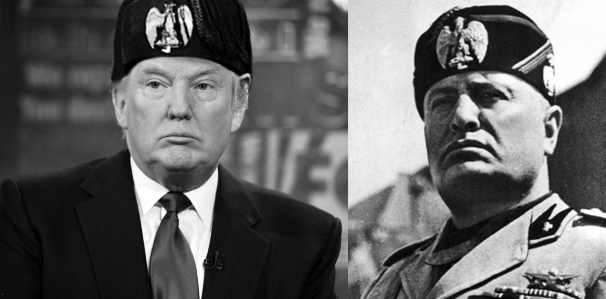
Washington, Dec. 8, 1941.
The alleged Japanese attack yesterday on the United States naval base at Pearl Harbor has resulted in cries around the country for President Franklin Roosevelt to ask Congress to declare war against the Empire of Japan and guarantee an inevitable triumph.
However, major newspapers and at least one broadcast outlet are questioning the accuracy of the reports of the attack. Ronald Dumph, an aspiring presidential candidate, says he doesn’t know who attacked Pearl Harbor. He says it could have been a 400-pound gorilla. Nobody really knows.
Dumph added that the U.S. should be friends with Japan—it’s a good thing. He feels the same way about Germany, whose leader, Adolf Hitler, he admires for making Germany great again. He says Herr Hitler enjoys the unbridled admiration of the German Nazis, which is more than you can say for some American leaders. Dumph has a thing for strongmen. He likes generals and people in uniform. He loves Mussolini because he made the trains run on time. Dumph rarely rides trains, but he enjoys striking Mussolini poses.
Dumph reportedly gets most of his information from Doc’s News. He doesn’t read newspapers but goes with his gut instincts, which are always right. He says we should get along with the Germans because it’s a good thing, and they also have cool uniforms. And he loves the heil Hitler salute. He doesn’t trust the Pearl Harbor reports because he says the media is the enemy of the people—unless it loves him.
Other sources say the evidence that the attackers were Japanese is compelling, including the fact that the airplanes had big red meatball insignia, and several crashed planes had guidebooks to Palm Beach in the cockpits written in Japanese, and empty sake bottles. Dumph, who does not drink, calls those reports “fake news” and prefers listening to the 160 radio stations that are owned by Kamikaze Media, reportedly a division of the Greater East Asia Co-Prosperity Group. Its stations tend to oppose anything President Roosevelt wants to do, and think—if the
Japanese really did attack—we probably had it coming.
Alas, that conditioning has led to abuse. Mainstream TV news on the big three networks is still pretty straight, but with the growth of cable, we have seen a trend toward presenting opinion as fact. It is an old idea, actually, used by Hitler, Mussolini and Japanese leaders. It is called propaganda.
Forgive me if I am a bit sensitive on this subject. I interviewed and wrote about the man who started it all —long before Roger Ailes insulted the aforementioned newsmen by launching Fox News. Ailes was in Philadelphia and had just starred in Joe McGinniss’ best-selling book, The Selling of The President-1968. The book described how Ailes ran a phony campaign, isolating Richard Nixon from the real press while staging rigged town halls in which Nixon answered prepared questions. And he won the election.
Ailes told me at the time that the media was controlled by Democrats, and made no secret that he wished for an outlet showing the other side. He got it decades later when he launched Fox News. That network was never “fair and balanced,” but it was tolerably mainstream at first. No more. It has become increasingly biased, so bad that it is now being described as state-controlled news, consistently distorting the facts of any story with political implications, promoting wild rumors, supporting Trump’s outrageous attacks on the media and government agencies such as the Justice Department and FBI—anything to please its favorite viewer,
President Trump.
The corruption has gone beyond reporting. The sex abuse scandals of its execs, starting with the late Ailes himself, have been sensational. It is true that there are some dissenting voices at Fox, but they are despised by many in its audience, for whom Fox is their sole source of information.
With Bill O'Reilly as one of the victims of the sexual harassment purge, Sean Hannity has become the favorite of Trump and his loyal base. So it appears to be a gift from providence for our argument that on Monday Hannity was exposed as the poster boy for Fox's corruption. It was revealed that Trump's fixer lawyer, Michael Cohen, has a close legal relationship to Hannity. It is hard to believe that anyone with any brains at all can take Hannity seriously in the future. But, they probably will.
Fortunately, there are signs that state sponsorship is beginning to fail. Some key personalities and contributors have left the network, unable to tolerate the culture. It is part of a general resistance to Trump propaganda. The governor of Oregon says she will refuse to send National Guard troops to the Mexican border. She may not have the final say on that, but the point is made. Defiance. Let us hope that a cure is found for the great media divide before we have another Pearl Harbor.

Congresswoman Debbie Wasserman Schultz has come to the aid of the beleaguered WAVE trolley—the one designed to solve Fort Lauderdale’s downtown traffic problems with 1890s technology. Schultz was quoted in the Sun-Sentinel to the effect that killing the WAVE deal, as recently elected city commissioners have vowed to do, would be a mistake. She says the city would have difficulty attracting federal money for any future projects. She added that the trolley is needed to relieve traffic. She also said the city had an obligation to those who made investments in downtown based on the expectation that the trolley was coming.
The strength of Ms. Schultz’s opinions has been weakened since her embarrassing removal as Democratic National Chairman after her committee was accused of favoritism in backing a candidate in the last presidential election, but she is probably right about a refusal to accept federal money leading to difficulty getting money in the future. But she is definitely wrong in saying the trolley will relieve congestion. No vehicle that blocks a lane of traffic is going to spell relief. It would be a different story if the trolley had a dedicated lane for its tracks, as new light rail systems have in other cities. The trolleys shoot right past lines of cars, encouraging people to abandon those cars in favor of the faster mode.
And the argument about investors is wrong. It’s the other way around. The WAVE was used as an excuse for developers to get approvals for overbuilding without consideration for the traffic problems—on the spurious grounds that the trolley would enable people to leave their cars at home.
With so much time and money already invested in the WAVE, is there no way out of this mess? There is. The city should accept the government money and send those pretty artists' renderings up to Washington—pictures that show a futuristic trolley on lightly traveled streets—and say the system is up and running and is a great success. Only we need some more money because the electric bills are higher than expected, and there have been expensive lawsuits from families whose breadwinners have committed suicide when frustrated by gridlocked traffic when trolleys stop to discharge and board riders.
Chances are that with Washington in such chaotic condition, nobody will challenge this effort, but if they do, there are several options:
(1) Say that stealing from the government is traditional, as many in the Trump administration have been proving.
(2) If someone challenges that reasoning as problematic, say we were victims of fake news and really meant to say that the WAVE concept has had some change orders. These include giving up the idea of tracks in the street and overhead wires in favor of compact electric vehicles that can get out of traffic when serving passengers and run on well-publicized busy streets so often that as in Chattanooga or Atlantic City (the century old jitneys are not electric) you don’t need to follow a schedule because you can almost always see one coming a few blocks away.
That should certainly satisfy the U.S. Secretary of Transportation—if there is one—and the enormous savings of replacing the trolley with efficient electric buses would give the city money to use on something that the public really wants and needs—such as bringing back Maguires Hill 16.
Image via

If Ed Kennedy had died 20 years ago, instead of living to the ripe old age of 87, his departure from this life two weeks ago would have warranted an important obituary in the newspapers, maybe even page one. But with newspapers hurting, and not that many people even reading obits in print these days, the former Broward County commissioner had to settle for a paid, not very long sendoff in the Sun-Sentinel.
The brief obit did cover the man’s salient achievement, however. It recounted how as a Broward County commissioner from 1984 to 1992, he was an early advocate of a commuter rail. He was not the earliest, we must note. Anne Kolb deserves that distinction when she was commissioner in the early 1970s, but her vision turned out to be a long way off. A decade later, it was Kennedy who managed to bring three counties, historically not known for cooperation, into the compact that resulted in Tri-Rail. That was in 1989, and for a time, Kennedy was much in the news as Tri-Rail got off to a rocky start with late trains and disappointing ridership.
We got to know the man at the time. We were writing a column for the late Hollywood Sun-Tattler, and being a train junkie, we followed the problems of a system that everybody, including Ed Kennedy, knew was on the wrong track. Its initial reliability was hampered by the fact that its dispatching was controlled by its landlord railroad—the CSX. And, as happens with Amtrak trains all around the country, railroads give priority to their own freight traffic, even if that makes passenger trains chronically late.
We were sympathetic to Kennedy and Tri-Rail, a rare voice of hope amid a chorus of criticism from much of the media. We wrote of the challenges of a commuter train that missed by a mile the downtowns all along its 71-mile CSX route, while the nearby FEC tracks, perfectly positioned to the east and penetrating the commercial centers of Delray Beach, Boca Raton, Fort Lauderdale, Hollywood and Miami, were used exclusively by slow-moving freight trains. We illustrated the problem by trying to talk to the FEC about the possibility of using its tracks for passengers. We waited for weeks for a return phone call, and when it came, it was the president of the railroad. The FEC did not even have a PR person. Didn’t need one. The president, in a gruffly amiable way, said “Sorry Mac, no interest in commuters. We’re a freight railroad.”
Ed Kennedy appreciated our efforts, and was always available—even to meet a few times after work at Danny’s Downtown, a short-lived restaurant bar owned by the late Danny Chichester. It was in one of downtown’s taller buildings at the corner of Broward and Andrews avenues. It is now that green Bank of America building. Despite the pressure he may have felt, Kennedy was always upbeat and calm. It took some time, but eventually, his confidence was rewarded as Tri-Rail overcame its startup problems and turned into a useful train, gradually building ridership to 16,000 daily, despite the handicap of being on a track to nowhere. Its southern terminus was in a seedy neighborhood near Miami International, miles from the city’s booming business center. That will soon be changed, as the service is scheduled to be re-routed (along FEC tracks) into the heart of the city.
Ed Kennedy lived long enough to see the seeds he struggled to plant in the 1980s bear promising fruit after the FEC changed ownership and decided to re-enter the passenger field with Brightline, the fast train planned to connect Miami to Orlando. With that breakthrough, it is anticipated that Tri-Rail will at last use the right track, routing some trains to serve the core of fast-growing downtowns all along its right of way. Recently, Brightline has even hinted it might even serve commuters, with additional stops between West Palm Beach and Miami.
Too many politicians leave behind them a legacy of self-serving deals, sometimes even jail time. Ed Kennedy leaves behind something of value. He may have outlived the accolade, but amiable Ed Kennedy deserves a fond farewell.
Image via
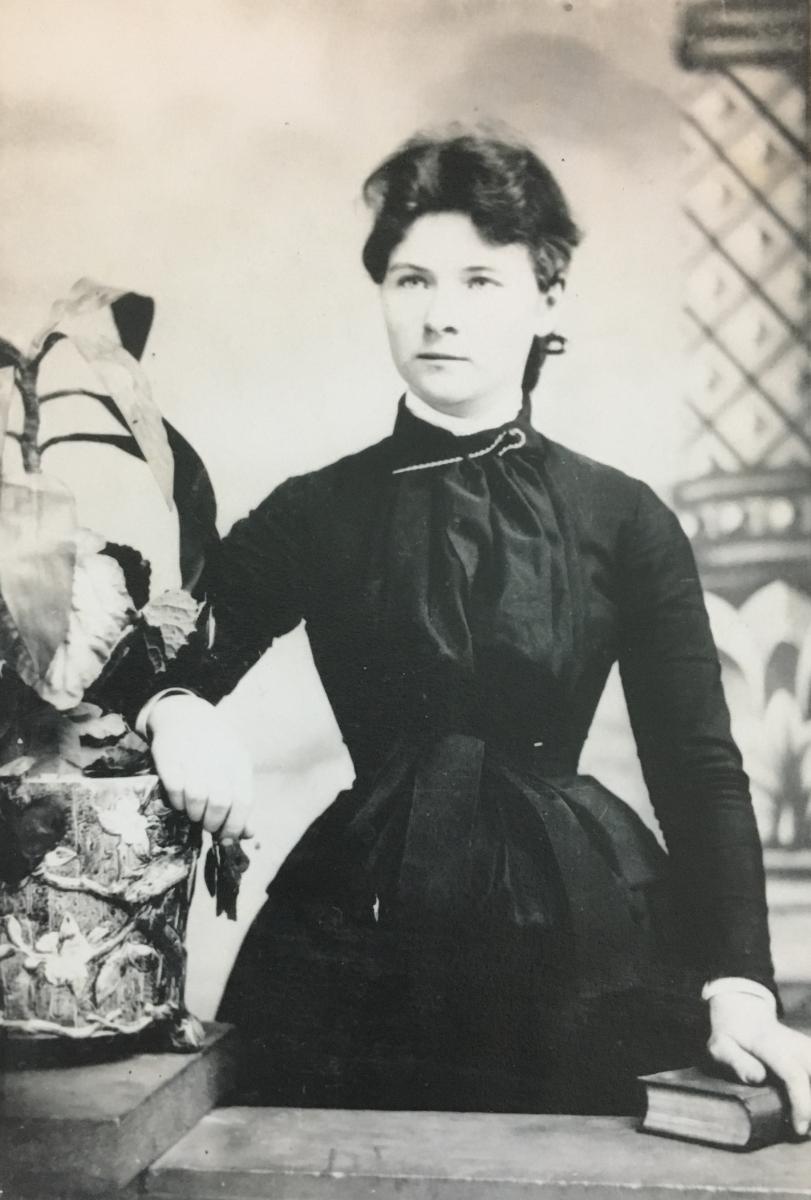
We all know the question about the one person in history we would most like to have dinner with or get to know a little bit. Would it be Judas Iscariot, Winston Churchill, Stormy Daniels? Those are all good choices, but not ours. We have long thought the person we would like to know better is Hugh McNeelis.
That’s how he spelled it—at least that’s what it says on his gravestone in Allentown, Pennsylvania. Other members of that clan have spelled it McNealis, McNelis, just plain Nelis and, in the case of one chap who moved to Australia—Nayliss. Hugh McNeelis is our great-great-grandfather, and we think of him this time of year and wonder how much he would enjoy what has become the season of St. Patrick.
He was not just another Irish immigrant. He was the first of our family to leave Ireland, in his case from Donegal. He lived about as far north as you can go. He came over in 1835, when he was 32 years old. This was a decade before the great wave of Irish immigration caused by the potato famine. But he did not stay long. He arrived with his newly married sister and brother-in-law, a fellow Donegal native named Tom McFadden. They landed in Brooklyn, New York, where the sister had a baby and died six months later. Hugh and Tom felt challenged with raising a baby, so they returned to Ireland.
They made it through the famine (four of mother’s great grandparents did not) and then re-emigrated around the time of the Civil War with the baby, also named Tom, now grown. Hugh McNeelis by then was married (to Tom McFadden’s sister) and had his own family, which he brought over all at once. That suggests he had more money than the average impoverished Irish immigrant. This time he settled in Allentown, where he owned a tailor shop.
That’s not unusual, for Donegal is famous for its tweed industry. But what was unusual was that Hugh McNeelis fancied genealogy—at a time when many Irish had never heard of the word. He kept records of every relative he could trace. Thus we know that his father was Michael McNeales, born around 1767. His mother was Catherine McCarron. Other names he traced to the 18th century include McFadden, of course, along with Sweeney (mother’s name) McGee, Gallagher, Campbell, Ward and Durning, all of Donegal. There is also O’Toole and O’Malley from County Mayo, Burke from Cavan and Ryan from Tipperary. The latter produced our most famous ancestor, Patrick John Ryan, who is believed to be a cousin of our great-grandmother. As a young priest he ministered to Confederate prisoners in St. Louis during the Civil War. He later was archbishop of Philadelphia from 1884 to 1912. He was a gifted orator and a charmer, credited with becoming friendly with the old line power structure and easing tensions between Irish Catholic immigrants and the Philadelphia Protestant establishment.
Hugh McNeelis lived long enough to know most of these relatives. At age 89 it took a train to kill him. He was struck by the Buffalo Express on the Lehigh Valley Railroad while bringing the cow home from pasture. By then he had passed along family records, including 19th-century photos, to his granddaughter, Kate McNealis (shown above as a young woman c. 1885). Her daughter Sara (Sweeney), our mother, updated them until her death in 1990.
And we wonder how old Hugh, who obviously had great pride in his Irish heritage, when earlier American settlers had contempt for the new immigrants, would feel today when a college football team takes pride in the name “Fighting Irish” and other teams go by names such as Celtics and Gaels. He did live long enough to see his countrymen literally fight their way toward respectability, partly because of their brilliant service in the Civil War. He knew that two young Gallagher relatives were among the many thousands of Irish who died preserving the Union.
But we still think he would be amazed to see Irish not just in the mainstream of American life, but celebrated each March as no other group in the country. Mick, once a slur, today offends few. Irish have become the symbol of American success. The name Kennedy has been described as American royalty. The surnames of people who once saw “No Irish Need Apply” signs have been adopted by more recent immigrants who want to appear American. No other group has family names prevalent as first names. Ryan, Bryan, Ward, Carroll, Kelly, Murphy, Nolan, Donovan, Grady, Connor, Riley, Murray, Neil—the list goes on. Most parents who select those names don’t even think of them as Irish.
This does not happen with other nationalities. You don’t find many people named Gaetano O’Brien, and for some reason Huizenga, Netanyahu and Putin have never really caught on as American first names.
It would be great fun to break bread, or share spirits, and discuss all this with Hugh McNeelis. Some day, God willing, we might. Until then, Stormy Daniels should suffice and might be nice.

A few weeks ago, the lead editorial in a Sunday edition of the Sun- Sentinel was one for the ages. It dealt with the extraordinary reaction by some South Florida political leaders to an extraordinary situation. Namely, the refusal of the state legislature to even consider a ban on military assault-style weapons in the wake of the Parkland tragedy, despite unprecedented appeals by so many people, including the eloquent Marjory Stoneman Douglas High School students, to do something about these weapons in the hands of unstable people.
The Sun-Sentinel applauded “local profiles in courage”—prominent South Florida leaders, and others in municipalities around the state, who are advocating what we might call “civic disobedience,” a government version of civil disobedience—defiance of the state government whose gun laws are dominated by redneck legislators who are either bought off directly by the National Rifle Association, or otherwise intimidated by the threat of political opposition in their next election. Among those saluted by the paper:
Coral Gables City Commissioner Frank Quesada and his colleagues for passing an assault weapons ban in that city—in defiance of a state law that local communities can’t pass gun control ordinances, and says such conduct is punishable by a $5,000 fine, removal from office and requirement to pay one’s own legal expenses.
Coral Springs Mayor Walter (Skip) Campbell, who is calling for a state initiative to ban assault weapons. He needs more than 700,000 signatures to get it on a ballot, but considering that polls show overwhelming support for gun control, that is possible.
Broward Commissioner Michael Udine, Parkland’s former mayor, who has been an outspoken advocate for an assault weapons ban.
Weston Mayor Dan Sterner, whose city commission is planning to sue the state to overturn present laws permitting such weapons. The Sun-Sentinel also cited Dania Beach and Boca Raton, who have passed resolutions calling for an assault weapons ban and other gun reforms.
The Sun-Sentinel showed its own courage by writing: “Many more communities need to join this overdue revolution.” It was, in effect, endorsing defiance of the state, encouraging civic disobedience. Later in the piece it added this strong assessment of the situation:
“This is an existential struggle between the gun lobby’s perverted idea of ‘freedom’ and the right of everyone else to freedom from fear and to life itself. To the NRA, ‘freedom’ means being able to manufacture, sell, buy and bear any weapon anywhere and anytime. If people die on that account, it’s the price of their ‘freedom.’”
Considering the decline of The Miami Herald’s circulation (and influence) in half of Broward and all of Palm Beach County, the Sun-Sentinel enjoys a monopoly over a broad stretch of the Gold Coast with the audience that still reads newspapers. That audience, although smaller than in the past, is still the power structure of the communities it serves.
Because the Sun-Sentinel’s circulation dies off around Delray Beach, our northern readers don’t often see it. But they have a consolation prize in the Palm Beach Post, whose opinions on the gun subject are in sync with the Sun-Sentinel. And they get a bonus with the popular local columnist, Frank Cerabino, who often adds a touch of humor to his insightful opinions on the subject of guns.
If the Sun-Sentinel’s editorial were designed to make people angry, it succeeded brilliantly. The only thing we might have added are the salaries earned by the NRA figures. Wayne LaPierre, the CEO, reportedly earns in the millions. Marion Hammer, the organization’s lobbyist who is credited with making Florida the leader in reckless gun-friendly laws was reported making in the hundreds of thousands—for relatively few actual working hours.
In the past, such a gutsy editorial from the Sun-Sentinel would have been close to shocking. But today, not so much, thanks to the leadership of Rosemary O’Hara, editorial page editor (above). In the opinion of the many newspaper people in the area, this woman has been one of the best things that have happened to local journalism in years.
Dan Christensen, former Miami Herald reporter who does the Florida Bulldog blog, an investigative outlet that has filled a void left when newspapers cut staff drastically, shares a common view with Ms. O’Hara: “She’s almost single-handedly brought respectability to the paper’s editorial page with her strong, thoroughly researched editorials. A side benefit is that she’s boosting the paper’s image in the community even as it dwindles in size and coverage.”
Well done, Ms. O’Hara. Well done, Sun-Sentinel.
Image courtesy of Rosemary O'Hara
